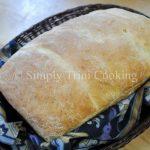
White Bread
Servings 1 loaf
Ingredients
- 3 1/2 cups all-purpose flour
- 1/2 cup lukewarm water
- 1/2 cup milk
- 1 envelop yeast
- 3 tbsp. butter melted
- 2 tbsp. brown sugar
- 1 tsp. salt
- 1 egg beaten
- Vegetable oil to grease the rising container
Instructions
- Coat a medium bowl and a 9" x 5" loaf pan with cooking spray or a little vegetable oil.
- In a large bowl, combine 3 cups flour, sugar, yeast and salt.
- In a small sauce pan, over medium heat, heat the milk and water until mildly warm.
- Add the melted butter and beaten egg. Mix thoroughly.
- Then pour slowly into the flour mixture and beat well. Begin mixing dough with a fork.
- Add the remaining flour slowly to help form a soft dough. You will have to proceed to using your hands after a few minutes.
- Lightly sprinkle a work surface with all-purpose flour. Turn the dough out on the surface and knead until smooth and elastic (this might take about 10 minutes).
- NOTE: You may have to incorporate a little more flour to the dough while you knead. Generally, this requires an additional 1/4 cup of flour.
- KNEADING THE DOUGH
- NOTE: Pulling and stretching the dough helps develop its gluten and incorporate air so the rise will be successful. Kneading requires you place your hands side by side on the dough and press firmly down with the heels.
- Flatten the dough to about 1/2" thick. Grasp the sides with both hands and fold it back on itself, flattening again, and again. Rotate the dough and repeat the stretching until the dough feels elastic, pliable and somewhat sticky.
- RESTING THE DOUGH
- Form into a ball. Place the smooth dough ball into the prepared greased bowl. Turn the dough one time so that you leave the top part oiled. Cover the bowl using plastic wrap then position in a warm place. Wait until the dough rises to about twice its original size (this might take about 45 minutes).
- (TIP: I've found to ensure the bowl is warm, I would pour hot water into the bowl. Empty, wipe clean and then grease before I place the dough to rise in it.)
- Monitor your dough while it rises. Test the dough to see if it is risen well. Poke with your finger. If the indentation slowly rises back, your dough is ready for shaping. If it rises very quickly, the dough needs more rising time. If it doesn't spring back, it has rested too long.
- Punch down the dough. Turn the dough onto the floured work surface and gently stretch and press into a rectangle (roughly about 20"x12").
- Roll up the sides into a thick cylinder, pinch the seams closed on each side, and turn so the the seams are underneath.
- BAKING THE DOUGH
- Place in a prepared pan, cover with a towel and allow to rise for another 10 to 15 minutes.
- The sides, after resting, should come in contact with the sides of the pan.
- Preheat the oven to 375 degrees F (190 degrees C). Bake until golden brown, or for 20 to 25 minutes.
- Remove from the pan and cool on a rack before slicing.
Notes
Yeast requires a warm environment of about 100 to 110 degrees F to begin growing.
A very warm environment of about 115 degrees F will kill the yeast. If you think the water is warm enough, but not hot, this setup is ideal.
Bread flour contains more gluten compared to all-purpose flour and will lead to a higher loaf.
Do not forget the salt to avoid the loaf from rising very quickly then falling.
A very warm environment of about 115 degrees F will kill the yeast. If you think the water is warm enough, but not hot, this setup is ideal.
Bread flour contains more gluten compared to all-purpose flour and will lead to a higher loaf.
Do not forget the salt to avoid the loaf from rising very quickly then falling.